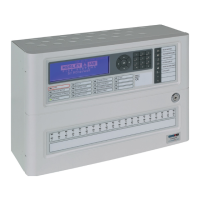
Do you have a question about the MORLEY-IAS DX CONNEXION and is the answer not in the manual?
| Brand | MORLEY-IAS |
|---|---|
| Model | DX CONNEXION |
| Category | Fire Alarms |
| Language | English |
Manufacturer's statement on accuracy, responsibility, and right to modify documentation.
Details the available enclosure sizes and loop configurations for the DX Connexion series.
Essential safety information including ESD, CE marking, LVD, CPD, EN54 compliance, and battery handling.
Information regarding national regulations, regional, and local wiring standards for installation.
Details the panel's compliance with EN54-2 and EN54-4 standards and optional functions.
Lists and illustrates components for small and medium enclosures.
Step-by-step instructions for mounting the enclosure on a surface.
Procedure for installing the enclosure using a bezel mount option.
Details on connecting external field wiring, including inspection and testing.
Instructions for installing standby batteries, including wiring and connection details.
Information on detection loop types, cable requirements, and wiring practices.
Guidance on connecting sounder circuits, including EOL resistors and wiring standards.
Details on configuring and wiring the panel's auxiliary relay outputs for various functions.
Information on connecting and utilizing the panel's auxiliary 24V DC supply outputs.
Instructions for connecting and monitoring digital inputs.
Details on connecting and configuring RS485 peripheral devices.
Guidance on routing cables within the enclosure for safety and compliance.
Instructions for fitting and configuring the optional keyswitch.
Defines the three user access levels and their associated capabilities.
Details the default and programmable passcodes for user access levels.
Provides abbreviations for device types displayed on the LCD.
Overview of programming methods: Fastrack, manual, and PC Configuration Tool.
Step-by-step guide to initial panel configuration using the Fastrack utility.
Detailed steps for manually programming the panel via its interface.
Configures system-wide settings like language, date format, and device behavior.
Covers learning devices on loops and editing their properties.
Details on editing location text, zone assignment, and disablement groups for devices.
Defines actions for inputs like fire, bomb alert, security, and access control.
Settings for output devices like sounders and relays, including patterns and silence options.
Process for the panel to automatically detect and configure devices on detection loops.
Programming for keyswitch, function keys, and monitored inputs.
Assigning descriptive text to zones for easy identification of locations.
Defines rules for activating outputs based on zone events and patterns.
Configures detection modes like Delayed, Verification, and Sensitivity.
Configures timed delays for fire alarm outputs and sounders.
Configures alarm verification timers to reduce false alarms from smoke detectors.
Adjusts detector sensitivity thresholds for day and night periods.
Sets default night-time detection thresholds, independent of chosen mode.
Schedules the activation of detection modes at specific times throughout the week.
Adjusts panel display contrast and clock drift compensation.
Resets the panel to factory default settings, clearing all configuration data.
Guide to using a PC tool for programming panel configuration parameters.
Process for downloading panel configuration data to a PC.
Procedure for uploading configuration data from a PC to the panel.
Details mechanical, environmental, and control/indication features of the panels.
Technical details on the panel's power supply unit, charger, and battery requirements.
Outlines daily, monthly, quarterly, and yearly maintenance tasks and checks.
Information on standby battery expected life and replacement recommendations.
Details the function and connections of the main Base PCB.
Describes the Display PCB, its connections, and replacement considerations.
Information on the panel's PSU variants and replacement procedures.
Steps for backing up data, performing the upgrade, and restoring settings.
Describes loop and linear network configurations and requirements.
Steps for configuring panel ID, text, topology, and remote panels.